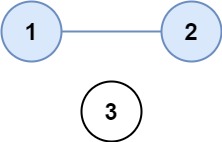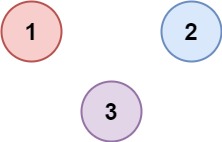547.Number of Provinces
===
###### tags: `Medium`,`Graph`,`DFS`,`BFS`,`Union Find`
[547. Number of Provinces](https://leetcode.com/problems/number-of-provinces/)
### 題目描述
There are `n` cities. Some of them are connected, while some are not. If city `a` is connected directly with city `b`, and city `b` is connected directly with city `c`, then city `a` is connected indirectly with city `c`.
A **province** is a group of directly or indirectly connected cities and no other cities outside of the group.
You are given an `n x n` matrix `isConnected` where `isConnected[i][j]` = 1 if the i^th^ city and the j^th^ city are directly connected, and `isConnected[i][j]` = 0 otherwise.
Return *the total number of **provinces**.*
### 範例
**Example 1:**

```
Input: isConnected = [[1,1,0],[1,1,0],[0,0,1]]
Output: 2
```
**Example 2:**

```
Input: isConnected = [[1,0,0],[0,1,0],[0,0,1]]
Output: 3
```
**Constraints**:
* 1 <= `n` <= 200
* `n` == `isConnected.length`
* `n` == `isConnected[i].length`
* `isConnected[i][j]` is 1 or 0.
* `isConnected[i][i]` == 1
* `isConnected[i][j]` == `isConnected[j][i]`
### 解答
#### C++
``` cpp=
class DisjointSet {
public:
vector<int> parent;
vector<int> size;
int count;
DisjointSet(int n) {
parent.resize(n);
size.resize(n, 1);
for (int i = 0; i < n; i ++) {
parent[i] = i;
}
count = n;
}
int find(int p) {
while (p != parent[p]) {
parent[p] = parent[parent[p]];
p = parent[p];
}
return p;
}
bool isConnected(int p, int q) {
return find(p) == find(q);
}
void union_(int p, int q) {
int rootP = find(p);
int rootQ = find(q);
if (rootP == rootQ) {
return ;
}
if (size[rootP] < size[rootQ]) {
parent[rootP] = rootQ;
size[rootQ] += size[rootP];
} else {
parent[rootQ] = rootP;
size[rootP] += size[rootQ];
}
count --;
}
};
class Solution {
public:
int findCircleNum(vector<vector<int>>& isConnected) {
ios_base::sync_with_stdio(0), cin.tie(0);
const int CONNECTED = 1;
int n = isConnected.size();
if (n == 1) {
return 1;
}
DisjointSet dset(n);
for (int u = 0; u < n; u ++) {
for (int v = 0; v < n; v ++) {
if (isConnected[u][v] == CONNECTED) {
dset.union_(u, v);
}
}
}
return dset.count;
}
};
```
> [name=Jerry Wu][time=4 June, 2023]
#### Python
```python=
class Solution:
def findCircleNum(self, isConnected: List[List[int]]) -> int:
n = len(isConnected)
ans = 0
visited = set()
def dfs(node):
visited.add(node)
for child, connect in enumerate(isConnected[node]):
if connect and child not in visited:
dfs(child)
for i in range(n):
if i not in visited:
dfs(i)
ans += 1
return ans
```
> [name=Yen-Chi Chen][time=Sun, Jun 4, 2023]
#### C#
```csharp=
public int FindCircleNum(int[][] isConnected) {
int size = isConnected.Length;
bool[] visited = new bool[size];
int provinces = 0;
for (int i = 0; i < size; i++) {
if (!visited[i]) {
provinces++;
DFS(i);
}
}
return provinces;
void DFS(int index) {
visited[index] = true;
for (int i = 0; i < size; i++) {
if (isConnected[index][i] == 1 && !visited[i]) {
DFS(i);
}
}
}
}
```
>[name=Jim][time=Jun 6, 2023]
### Reference
[回到題目列表](https://hackmd.io/@Marsgoat/leetcode_every_day)